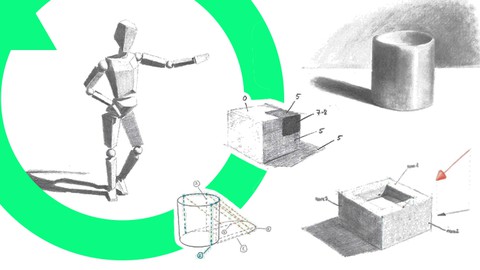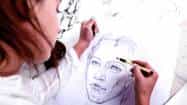What you’ll learn
- Make your drawings more believable to the viewer by shadows
- Shading techniques to create the illusion of reality
- How to add 3-dimensionality to your drawings
- Working with light & shadow
Requirements
- a pencil + some office papers
- no previous drawing knowledge is required
Description
In this beginner drawing course you can learn one of the most useful, rewarding and exciting drawing skills called shading or rendering. Understand how light & shadow work on different surfaces in order to create depth on you artworks. Whatever technique you prefer – sketching, drawing or painting – understanding how shadows are created is crucial for creating a believable illusion of reality (3D).
In this course I’ll show you the basics, as well as some of the advanced techniques of shading which you can use to create both simplistic and realistic drawings. We will go from simple to more complex forms step by step.
What previous drawing experience do you need?
Some basic drawing skills would be useful, but not mandatory for this course. I designed the lessons in a way that you can also benefit from it with very little or zero previous drawing experience.
What drawing tools do you need?
You can start this beginner drawing course without any special drawing tool. I’ll be using mostly a regular 2B graphite pencil on cheap office papers. For demonstration purposes I will also use some other drawing tools which you can purchase along the way if you like them.
What can you expect by completing this course?
You will understand how light and shadow work on simple forms. And if you know that complex objects are built from simple forms, actually you will know a lot. You will know the basic terms and concepts of shading, and you’ll be able to make eye-catching, believable, well-shaded realistic drawings or sketches about simple subjects. There will be plenty of drawing exercises, so your drawing skills will get a huge boost. By the end of this course you’ll also be ready to explore more advanced shading techniques without difficulties.
Course Content
Day 1 – Light & Shadow
- Value change equals form change
- Pencil grades
- The value scale
- Some shading techniques
- Light & Shadow
- Direction of Light
- The ideal lighting setup
- The “1-2-3 read” concept
- How to assign values to surfaces
- Day 1 Assignment (shading exercise)
Day 2 – The Cast Shadow
- What is cast shadow?
- The cast shadow of a stick
- Quick perspective drawing overview
- The cast shadow of the cube
- Sunlight & local light scenario
- The line of termination
- Cast shadow of a complex planar form
- Day 2 Assignment (cast shadow construction drawing exercise)
Day 3 – Curved Volumes
- The cast shadow of the cylinder
- The occlusion shadow
- The cast shadow of the cone
- Soft shadow edges
- The cast shadow of the sphere
- Different lighting setups for the sphere (top light, back light, side light)
- Day 3 Assignment (cast shadow construction and realistic shading exercise)
Day 4 – The Form Shadow & the Light Side
- The core shadow
- How to shade the light side
- Shadow cast on other objects
- How to shade concave surfaces
- Shading a hollow brick shape
- Shading a sphere with inward curve
- Realistic shading of a coffee mug
- Blending values
- The background value
- More shading techniques
- Day 4 Assignment (all kinds of shading exercises)
Day 5 – Figure Shading Studies
- Putting it all together
- Plan your shadow pattern
- Shading with graphite pencil
- Shading with charcoal pencils on colored paper
- Shading with dye inks (marker)
- Shading with color pencils
- Day 5 Assignment (create your own figure shading)
If you’d like to take your drawing skills to the next level, enroll in this course now!
See you in the first lesson!
Author(s): Tamas Benko



